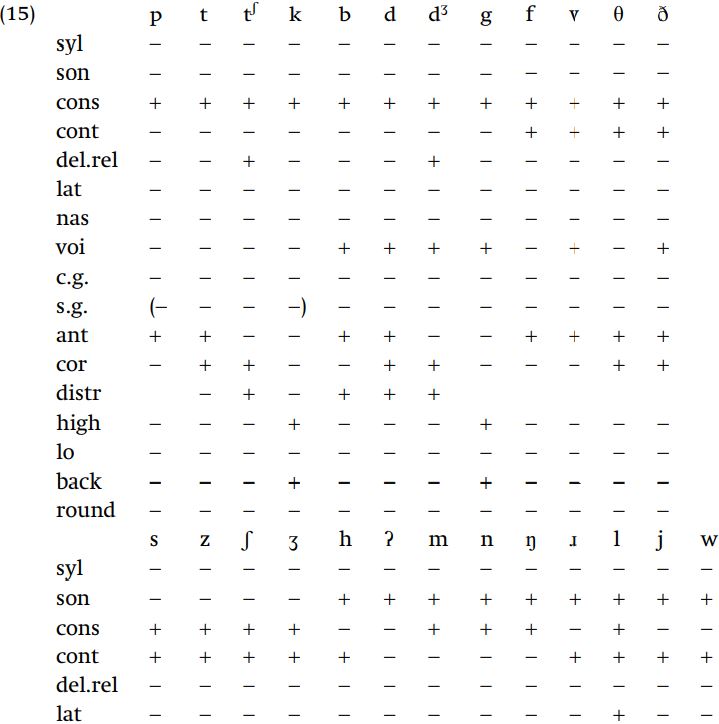


 Grammar
Grammar
 Tenses
Tenses
 Present
Present
 Past
Past
 Future
Future
 Parts Of Speech
Parts Of Speech
 Nouns
Nouns
 Verbs
Verbs
 Adverbs
Adverbs
 Adjectives
Adjectives
 Pronouns
Pronouns
 Pre Position
Pre Position
 Preposition by function
Preposition by function 
 Preposition by construction
Preposition by construction
 Conjunctions
Conjunctions
 Interjections
Interjections
 Grammar Rules
Grammar Rules
 Linguistics
Linguistics
 Semantics
Semantics
 Pragmatics
Pragmatics
 Reading Comprehension
Reading Comprehension|
Read More
Date: 2024-05-24
Date: 2024-07-02
Date: 2023-05-16
|
Features combine quite freely, so we cannot give a complete list. By learning some specific feature values and applying your knowledge of the meaning of features, it should be possible to arrive at the feature values of other segments. This is, of course, possible only if you know relevant phonetic details of the sound that you are considering. In order to know the feature values of [ɭ], you need to know that this is the symbol for a retroflex lateral approximant, thus it has the features appropriate for [l], and it also has the features that characterize retroflex consonants, which are [-ant, -distr]. If you do not know the phonetic characteristics of the segment symbolized as [ʕ], it is necessary to first understand its phonetic properties – it is a voiced pharyngeal continuant – before trying to deduce its feature values. In reading descriptions of languages, it is also important to understand that a symbol used in published data on a language is not always used according to a particular standard of phonetic transcription practices at the moment, so read the phonetic descriptions of letters in the grammar carefully!
The standard feature values for the consonants of (American) English are given in (15), to help you understand how the entire set of features is applied to the sound inventory of a language which you are familiar with.


The assignment of [spread glottis] – aspiration – in English stops varies according to context, so the value [-s.g.] is in parenthesis in the chart because both values of this feature are found on the surface, depending on context. The value [-s.g.] represents the underlying value.
Vowel feature summary. Certain feature values are uniform for all vowels: [+syl, -cons, +son, +cont, -del.rel, -ant, -lat, -distr]. Typically, vowels are also [+voice, -s.g., -c.g.]. There are languages such as Mazateco and !Xoo where breathy voicing and glottalization are used contrastively, so in these languages [+s.g.] and [+c.g.] are possible specifications. A number of languages have phonetic voiceless vowels, but the phonological status of voiceless vowels is not so clear, thus it may be that there are no phonologically [-voice] vowels. Values of the main features used to distinguish vowels are given in (16). (Recall that we are not certain whether [tense] applies to low vowels.)

Nasality, length, breathiness and creaky voice are properties freely available to vowels, so any of these vowels can have  nasal,
nasal,  long,
long,  s.g. or
s.g. or  c.g. counterparts.
c.g. counterparts.
Consonant feature summary. Primary place of articulation for consonants is summarized in (17), using continuant consonants (voiceless in the first row, voiced in the second: numbers in the third row are keyed to traditional place of articulation terms). Continuant consonants are used here because they exhibit the maximum number of distinctions, for example there are bilabial and labiodental fricatives, but only bilabial stops. All of these consonants are [-syl, +cont, -del.rel, -nas, -lat, -c.g., -tense, -round].

Secondary place of articulation is illustrated in (18), here restricted to secondary articulations on [p t]. All of these consonants are [-syl, -son, +cons, -cont, -del.rel, -lat, -nas, -voice, -s.g., -c.g., -tense].

Round consonants might simply have the specification [+round]. Tongue raising and backing is not necessary in order to achieve rounding, whereas tongue raising and backing is by definition necessary in order to have a velarized consonant.
A final important point must be made. The twenty-one features discussed here – syllabic, sonorant, consonantal, high, low, back, round, tense (advanced tongue root), coronal, anterior, strident, distributed, continuant, delayed release, nasal, lateral, spread glottis, constricted glottis, voice, long, stress – are specific empirical hypotheses. This means that they are subject to change in the face of evidence that a change is required, so they are not immutable. On the other hand, as scientific hypotheses, they must be taken seriously until good evidence is presented that another system of features is better . Features should not be invented willy-nilly: using distinctive features is not the same as placing a plus sign in front of a traditional articulatory description, and thus describing sounds as [+mid], [+alveolar] or [+vowel] misconstrues the theoretical claim of distinctive features.
|
|
|
|
تفوقت في الاختبار على الجميع.. فاكهة "خارقة" في عالم التغذية
|
|
|
|
|
|
|
أمين عام أوبك: النفط الخام والغاز الطبيعي "هبة من الله"
|
|
|
|
|
|
|
قسم شؤون المعارف ينظم دورة عن آليات عمل الفهارس الفنية للموسوعات والكتب لملاكاته
|
|
|